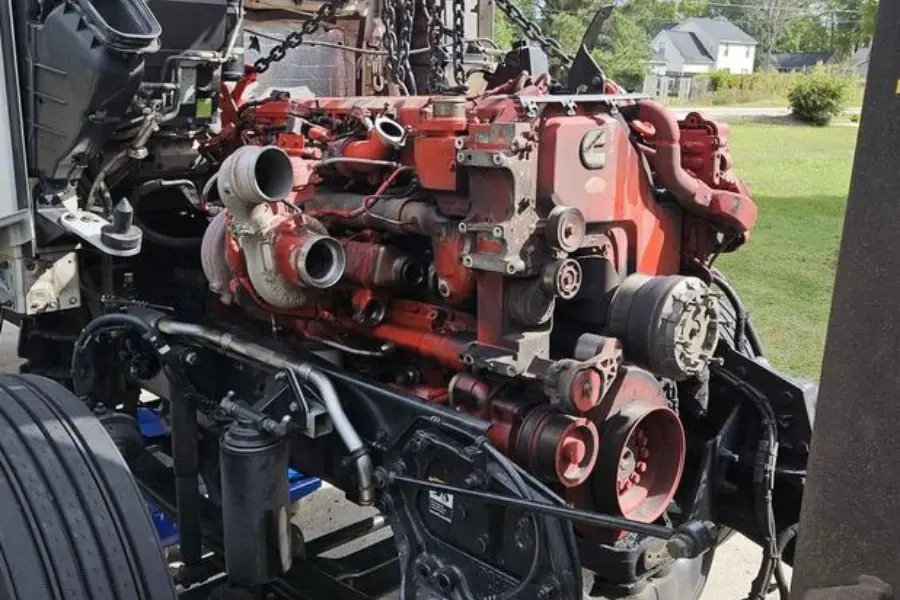Cummins ISX15 oil pressure problems can be caused by various factors that include worn-out oil pumps, faulty pressure sensors, clogged oil filters, or low oil levels.
Causes of Cummins Isx15 Oil Pressure Problems
When it comes to the Cummins ISX15 engine, oil pressure problems can arise due to various factors. Understanding the causes of these problems is essential for diagnosing and resolving them effectively. Below, we will explore four common culprits behind Cummins ISX15 oil pressure issues:
Clogged Oil Filter
A clogged oil filter can significantly impact the oil flow and, consequently, the oil pressure in your Cummins ISX15 engine. Over time, the filter can accumulate debris, dirt, and sludge, obstructing the oil passage and restricting its flow. As a result, the proper amount of oil fails to reach vital engine components, leading to decreased oil pressure.
Oil Pump Failure
The oil pump plays a crucial role in maintaining adequate oil pressure in the Cummins ISX15 engine. However, with continuous use, it may experience wear and tear, resulting in reduced effectiveness.

When the oil pump fails, it fails to deliver the necessary oil pressure, potentially causing damage to engine parts. This particular cause of oil pressure problems requires immediate attention and replacement of the faulty oil pump to prevent further complications.
Low Oil Level
Ensuring the engine has a sufficient amount of oil is vital for maintaining the proper oil pressure in the Cummins ISX15. When the oil level drops below the manufacturer’s recommended level, it reduces the amount of pressurized oil flowing through the engine, leading to inadequate oil pressure. Regularly checking and topping up the oil level can help prevent such issues and keep the engine running smoothly.
Oil Viscosity Issues
The viscosity, or thickness, of the oil also plays a significant role in maintaining optimal oil pressure in the Cummins ISX15 engine. If the oil used is too thin or has a low viscosity, it may struggle to create enough pressure to lubricate and protect vital engine components adequately.
On the other hand, high viscosity oil can cause increased resistance, resulting in reduced oil flow and pressure. Ensuring that you use the recommended oil with the appropriate viscosity for your engine can prevent viscosity-related oil pressure problems.
By understanding and addressing these common causes of Cummins ISX15 oil pressure problems, you can ensure the longevity and optimal performance of your engine. Regular maintenance, including timely oil changes and filter replacements, can go a long way in preventing such issues and providing a smooth operating experience for your Cummins ISX15 engine.

Troubleshooting Cummins Isx15 Oil Pressure Problems
Checking for Oil Leaks and Fixing Them
If you are experiencing oil pressure problems with your Cummins ISX15 engine, the first step in troubleshooting is to check for oil leaks and promptly fix them. Oil leaks can significantly affect the oil pressure, leading to performance issues and potential engine damage. Here’s how you can identify and resolve oil leaks:
- Inspect the engine and surrounding components for any signs of oil leakage.
- If you notice any visible oil leaks, trace the source of the leak and determine the necessary repairs or replacements.
- Common areas prone to oil leaks include gaskets, seals, and the oil filter housing. Ensure that all seals are in good condition and properly seated.
- Tighten loose fittings and connections to prevent oil leakage.
- Regularly monitor the engine for new oil leaks and address them promptly to avoid further complications.
Inspecting and Cleaning Oil Filters
An oil filter that is clogged or dirty can affect the oil pressure in your Cummins ISX15 engine. Regular inspection and cleaning of the oil filters are essential to ensure proper oil flow and maintain the desired pressure levels. Here’s what you need to do:
- Locate the oil filters in your engine. Typically, there are both a primary and secondary oil filter.
- Check the condition of the oil filters. If they are excessively dirty or clogged, they need to be cleaned or replaced.
- Remove the filters according to the manufacturer’s instructions.
- Clean the filters using an appropriate cleaning solution, ensuring all debris and build-up are removed.
- If the filters are damaged or cannot be properly cleaned, replace them with new ones.

Testing and Replacing the Oil Pressure Sensor
The oil pressure sensor plays a crucial role in monitoring and regulating the oil pressure within your Cummins ISX15 engine. If the sensor is faulty or malfunctioning, it can give inaccurate readings or fail to detect pressure fluctuations, leading to oil pressure problems. Follow these steps to test and replace the oil pressure sensor:
- Locate the oil pressure sensor, which is typically mounted on the engine block or near the oil filter.
- Use a suitable diagnostic tool to test the oil pressure sensor’s functionality.
- If the sensor is not working correctly, replace it with a new one.
- Ensure proper installation of the new oil pressure sensor, following the manufacturer’s guidelines.
- Perform a test run to verify that the new sensor is providing accurate readings.
Flushing the Engine and Replacing the Oil
Over time, oil contaminants can accumulate and affect the oil pressure in your Cummins ISX15 engine. Flushing the engine and replacing the oil on a regular basis helps maintain optimal oil pressure and prolong the engine’s life. Here’s how you can flush the engine and replace the oil:
- Allow the engine to cool down completely before starting the flushing process.
- Drain the old oil by removing the drain plug and letting the oil flow into a suitable container.
- Once all the old oil is drained, replace the drain plug and tighten it securely.
- Add a suitable engine oil flushing agent to the engine according to the manufacturer’s instructions. Run the engine for the recommended period to allow the flushing agent to work.
- After the flushing time has elapsed, shut down the engine and drain the flushing agent along with any remaining contaminants.
- Replace the oil filter with a new one and fill the engine with the recommended oil type and quantity.
- Start the engine and check for any oil pressure abnormalities.
By following these troubleshooting steps for oil pressure problems in your Cummins ISX15 engine, you can address the underlying issues and ensure optimum performance and reliability. Regular maintenance and prompt attention to oil pressure problems will help keep your engine running smoothly and efficiently.
Common Signs of Oil Pressure Problems in Cummins Isx15
The oil pressure in the Cummins ISX15 engine is crucial for its optimal performance and longevity. However, just like any other mechanical component, the oil pressure system can experience problems over time.

It is essential to be aware of the common signs that indicate oil pressure issues in your Cummins ISX15 engine. This knowledge will help you identify and address potential problems before they cause severe damage or lead to costly repairs. Here are some common signs you should watch out for:
Oil Pressure Warning Light
One of the primary indicators of oil pressure problems in your Cummins ISX15 engine is the oil pressure warning light. This light is typically located on the dashboard and illuminates when there is a drop in the oil pressure. Ignoring this warning light can result in serious engine damage, so it’s crucial to take immediate action when it illuminates.
If you notice the oil pressure warning light illuminated or flashing, it is recommended to pull over safely and shut off the engine to prevent further damage.
Engine Knocking or Ticking Noise
Another sign of oil pressure problems in the Cummins ISX15 engine is the presence of engine knocking or ticking noises. Insufficient oil pressure can cause friction and metal-to-metal contact within the engine, resulting in these abnormal sounds.
If you notice any unusual knocking or ticking noises coming from your engine, it is important to have it checked by a qualified technician to determine the cause and prevent potential engine damage.
Low Oil Pressure Reading on the Gauge
Monitoring the oil pressure gauge is an effective way to detect oil pressure problems in your Cummins ISX15 engine. A low oil pressure reading on the gauge can indicate an issue with the oil pump, oil filter, or other components of the oil pressure system.
If you consistently observe low oil pressure readings on the gauge, it is essential to have the engine inspected and serviced by a professional to prevent further damage.
Engine Overheating
Oil plays a vital role in cooling the engine components and reducing friction. When there is a decrease in oil pressure, the engine can experience overheating due to inadequate lubrication and cooling. Persistent engine overheating can lead to significant damage and even engine failure if not addressed promptly.
If you notice your engine temperature gauge constantly rising or your engine is overheating, it is crucial to have the oil pressure system checked as a possible cause.
Preventive Measures to Maintain Oil Pressure in Cummins Isx15
Regular maintenance is crucial for keeping your Cummins ISX15 engine in optimal condition, and one of the key aspects to focus on is maintaining proper oil pressure. Without sufficient oil pressure, your engine’s components may not receive the necessary lubrication, leading to potential damage and decreased performance.
Regular Oil Changes and Filter Replacements
Regularly changing the oil and replacing the filters is one of the fundamental preventive measures to maintain oil pressure in the Cummins ISX15 engine. Over time, oil may become contaminated with dirt, debris, and impurities, while filters can become clogged, restricting the flow of oil.
By adhering to a strict oil change schedule and regularly replacing filters, you can prevent oil pressure problems and promote the smooth operation of your engine.
Using High-quality Oil and Filters
The quality of the oil and filters you use in your Cummins ISX15 engine can significantly impact its oil pressure. Opt for high-quality oil that meets the manufacturer’s specifications and is specifically formulated for the demands of your engine.
Similarly, choose filters that are designed for your engine model to ensure optimum filtration efficiency. Using cheap and substandard oil and filters can lead to oil pressure issues in the long run.
Monitoring Oil Levels and Pressures
To prevent oil pressure problems, it’s important to regularly monitor the oil levels and pressures of your Cummins ISX15 engine. Keep an eye on the oil pressure gauge or indicator on your dashboard while the engine is running.
If you notice any sudden drops in oil pressure or inconsistent readings, it might be an indication of an underlying issue that requires attention. Regularly check the dipstick to ensure the oil levels are within the recommended range.
Keeping the Cooling System in Good Condition
The cooling system of your Cummins ISX15 engine plays a vital role in maintaining proper oil pressure. Excessive heat can cause oil to break down and lose its lubricating properties, leading to decreased oil pressure.
Regularly inspect and maintain the cooling system components, including radiator, hoses, and coolant levels, to ensure proper temperature regulation. Address any cooling system issues promptly to prevent potential oil pressure problems.
By adhering to these preventive measures, you can maintain optimal oil pressure in your Cummins ISX15 engine, promoting its longevity and performance.
Professional Assistance for Resolving Cummins Isx15 Oil Pressure Problems
Experiencing oil pressure problems with your Cummins ISX15 engine can be a frustrating and concerning issue. However, with the help of professional assistance, these problems can be resolved effectively and efficiently.
When dealing with oil pressure issues in your Cummins ISX15 engine, it is crucial to consult a certified Cummins technician, use Cummins diagnostic tools, consider replacing faulty oil pump or components, and seek expert advice for complex issues. In this article, we will explore each of these approaches in detail to provide you with the guidance you need to address your Cummins ISX15 oil pressure problems.
Consulting a Certified Cummins Technician
When faced with Cummins ISX15 oil pressure problems, consulting a certified Cummins technician is the best course of action. These highly trained professionals possess the knowledge and expertise necessary to diagnose and resolve oil pressure issues in your engine.
They are equipped with the latest Cummins-specific diagnostic tools and software, allowing them to accurately pinpoint the root cause of the problem. By consulting a certified Cummins technician, you can be confident that your oil pressure problem will be addressed with precision and care, ensuring the longevity and optimal performance of your Cummins ISX15 engine.
Using Cummins Diagnostic Tools
To effectively address oil pressure problems in your Cummins ISX15 engine, utilizing Cummins diagnostic tools is essential. These tools are specifically designed to communicate with your engine’s control module, gathering crucial data and identifying any potential issues.
By connecting these diagnostic tools to your Cummins ISX15 engine and running diagnostic tests, a certified Cummins technician can obtain valuable insights into the oil pressure problem. This diagnostic data serves as a roadmap, guiding the technician towards the appropriate solution, whether it involves adjusting engine parameters, replacing faulty components, or performing further diagnostics.
Replacing Faulty Oil Pump or Components
In some instances, the root cause of Cummins ISX15 oil pressure problems may lie within the oil pump or its components. Faulty oil pumps or worn-out components can lead to inadequate oil pressure, jeopardizing the overall performance and reliability of your engine. When diagnosed with a faulty oil pump or components, replacing them becomes essential.
By relying on genuine Cummins parts and the expertise of a certified Cummins technician, you can ensure that your engine receives the necessary replacement parts and that the installation is carried out correctly, restoring proper oil pressure and safeguarding your Cummins ISX15 engine.
Seeking Expert Advice for Complex Issues
While some Cummins ISX15 oil pressure problems may have straightforward solutions, others can be more complex and require expert advice. In certain situations, underlying issues may be contributing to the oil pressure problem, which necessitates a thorough investigation and in-depth knowledge of Cummins engines.
Seeking the guidance of experienced Cummins technicians and experts can help you navigate through these complex issues. Their expertise allows them to identify potential underlying causes, suggest specialized diagnostic procedures, and recommend suitable solutions to efficiently resolve the problem.
By following these approaches and seeking professional assistance, you can effectively resolve Cummins ISX15 oil pressure problems. Whether consulting a certified Cummins technician, using Cummins diagnostic tools, replacing faulty oil pump or components, or seeking expert advice for complex issues, addressing oil pressure problems promptly ensures the continued performance and reliability of your Cummins ISX15 engine.
Common Mistakes to Avoid when Dealing with Cummins Isx15 Oil Pressure Problems
If you own a Cummins ISX15 engine, it’s crucial to understand the common mistakes to avoid when dealing with oil pressure problems. Ignoring warning signs, using incorrect oil or filters, neglecting preventive maintenance, and attempting complex repairs without professional help are some of the mistakes that can lead to major engine damage and costly repairs.
In this section, we will discuss each of these mistakes in detail and provide valuable insights to help you keep your Cummins ISX15 engine running smoothly.
Ignoring Warning Signs and Continuing to Drive
When it comes to oil pressure problems, ignoring warning signs and continuing to drive your vehicle can have severe consequences. If you notice any of the following signs, it’s essential to address the issue promptly:
- Dashboard warning lights indicating low oil pressure
- Unusual engine noises, such as knocking or ticking
- Oil leaks or oil spots underneath the vehicle
- Poor engine performance or decreased power
Continuing to drive your vehicle without addressing these warning signs can cause irreparable damage to your engine, resulting in costly repairs or even engine failure. It is imperative to take immediate action if you encounter any of these symptoms.
Using Incorrect Oil or Filters
Using the correct oil and filters is vital for maintaining optimal oil pressure and overall engine health. Using incorrect oil or filters can lead to oil starvation, decreased lubrication, and increased wear and tear on engine components. It is crucial to follow the manufacturer’s recommendations and use oil and filters specifically designed for the Cummins ISX15 engine.
When selecting oil, look for the recommended viscosity and quality standards specified by Cummins. Using low-quality oil or a viscosity that is not suitable for your engine can lead to poor oil pressure and increased engine wear. Similarly, using non-genuine or incompatible filters can result in restricted oil flow, leading to oil pressure problems.
Neglecting Preventive Maintenance
Neglecting preventive maintenance is another common mistake that can contribute to oil pressure problems in the Cummins ISX15 engine. Regular maintenance, including oil changes, filter replacements, and inspections, is crucial for preserving engine performance and preventing oil pressure issues.
Make sure to adhere to the recommended maintenance schedule provided by Cummins. Regular oil changes are particularly important as old, contaminated oil can lead to sludge buildup, clogged filters, and reduced oil pressure. By neglecting preventive maintenance, you risk compromising the longevity and reliability of your engine.
Attempting Complex Repairs Without Professional Help
While it’s commendable to tackle minor repairs on your own, attempting complex repairs without professional help can be risky, especially when dealing with oil pressure problems in the Cummins ISX15 engine.
The complexity of these issues often requires extensive knowledge, specialized tools, and experience to diagnose and fix them correctly. If you are not a trained mechanic or lack the expertise in troubleshooting oil pressure problems, it’s best to seek professional assistance.
Professional mechanics have the necessary skills and resources to accurately diagnose the root cause of the issue and perform the required repairs, ensuring the long-term health and reliability of your engine.
FAQs on Cummins Isx15 Oil Pressure Problems
The normal oil pressure on a Cummins ISX15 engine typically ranges from 40 to 60 psi (pounds per square inch).
Low oil pressure in troubleshooting can be caused by issues such as a worn-out oil pump, clogged oil filter, or oil leaks. In diesel engines, common causes of low oil pressure include faulty oil pressure sensors, worn-out crankshaft bearings, or inadequate oil levels. Ensure timely maintenance to prevent these problems.
Oil pressure in a diesel truck can drop due to several potential causes. These include issues with the oil pump, oil filter, or a leak in the system. Additionally, a faulty pressure relief valve or worn engine bearings can also contribute to this problem. Regular maintenance and inspections are essential to prevent oil pressure issues.
Conclusion
To overcome Cummins ISX15 oil pressure problems, it is crucial to regularly maintain and monitor the engine. Timely oil changes, the use of high-quality filters, and proper engine warm-up are essential. Additionally, paying attention to warning signs, such as low oil pressure indicators or unusual engine noises, can prevent major damage.
By following these steps, you can ensure the longevity and smooth functioning of your Cummins ISX15 engine.




